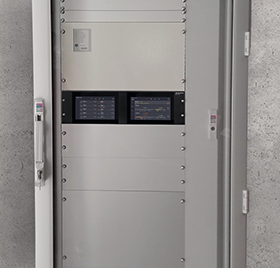

Fire detection is a crucial aspect of security in educational establishments, but it is only as good as the information it provides. While the basic ability to sound an alarm remains critical, modern connectivity means staff on site can better monitor, maintain and understand their fire detection system. This makes the whole system more versatile, reliable and cost-effective, and allows for very rapid intervention should a fire be detected.
Already networked, high security environments are embracing fire detection systems that also support remote visualisation and operation. Airport security zones, laboratories, and sensitive IT environments are some of the application areas that have pioneered this approach, which allows staff in a command centre to monitor a whole fire detection system from one location. Ideally, this monitoring is aided by intuitive visualisation – either maps on a normal computer screen or a layered touchscreen approach that allows operators to rapidly narrow down information to the key facts they need in an emergency.
Arguably, this modern ‘smartphone’ approach to fire safety is even more important and useful to educational establishments than it is to high security environments. In a large school or on a university campus, it is crucial to detect fires rapidly in order to ensure enough egress time for the large numbers of students and staff that may be on the premises. This means using sensitive detection technology, such as aspirating smoke detectors. However, this sensitivity comes at a risk of false alarms, which would be highly disruptive or even dangerous if they resulted in a full emergency evacuation involving thousands of panicked students.
Advantages of a staged response
The best way to balance these conflicting needs of sensitivity and reliability is by using a staged response; this would be greatly aided by a detection system that delivers full and clear information to those responsible for safety on site. A typical staged response would see one or even several levels of ‘alert’ raised by the system depending on smoke concentrations being detected. At the lowest level of alert, the desired response is to get a suitable member of staff to the flagged area as quickly as possible. They could directly tackle a small incipient fire if it was merely smouldering; raise the alarm and start evacuations if necessary; or they could report that no action was needed, in which case, the system could be re-set.
At the same time as maintenance or security staff go to investigate the initial alert, the system would continue to evaluate the situation and, if the smoke level increases, raise the alert or alarm status accordingly. Ultimately, such systems are also able to sound a full alarm, activate suppression systems and automatically call the local fire brigade – but the aim of the staged response is to prevent the need for such drastic measures with successful early intervention.
Early warning is more efficient
Finding and tackling a fire in its incipient stage is far easier than dealing with it once it has gained momentum. This is the idea behind
Fires build exponentially so, if the opportunity to intervene at this stage is missed, staff are likely to be confronted by a growing conflagration, too dangerous to fight without specialist equipment and training. Although professional firefighters would easily deal with such a blaze, at this point they still would be in the station. In the time it would take to alert them, their arrival, assessment of the situation and deployment of their equipment, the fire would have grown and spread, ensuring that damage is widespread and serious.
For a business, this is often deadly, because while the physical damage can be insured, the loss of business and contacts in the aftermath cannot. In the case of an educational establishment, the current crop of students will have nowhere to study and their education will be severely interrupted at a crucial stage.
Information supports the staged response
Avoiding severe damage and business/education interruption has been the driving force behind the adoption of EWFD, which usually goes well beyond the level of fire safety required by law. However, so far efforts have been concentrated on detection sensitivity and to an extent, staff training. Securiton’s leading EWFD system – the SecuriSmoke aspirating smoke detector (ASD) – has also embraced the information angle. Securiton’s FidesNet for ASD brings the system into the modern age, with a smartphone-style touchscreen that allows maintenance staff to assess faults and pre-alarms without disturbing lessons or compromising security.
FidesNet offers easy remote visualisation and operation of aspirating smoke detectors. It is also indispensable for connecting to other systems via standardised interfaces. If, for example, the security management system at a university campus receives relevant ASD data, the operator can call up the status of any detector on the system. The FidesControl unit allows easy on-site reading of the situation from a 7-inch touch panel. The detectors can be isolated by channel and are easy to reset in the event of an error or alarm.
Touchscreens will become the norm
Just as they have become ubiquitous in cars, on machinery and for entertainment, these intuitive, smartphone-style displays are likely to become increasingly common in fire detection. This is because easy access to relevant information is crucial to any best practice response to fire incidents. When it comes to a staged response – which any major institution or building should be adopting – information is critical.
Where is the incident? What is the alert level? How is it progressing? Information that staff need to know, within seconds. The ability to reset, react to faults and conduct regular checks easily and without costly backup are further advantages of a modern, smartphone-style style command console that integrates the fire detectors making up your main line of defence.

© Technews Publishing (Pty) Ltd. | All Rights Reserved.